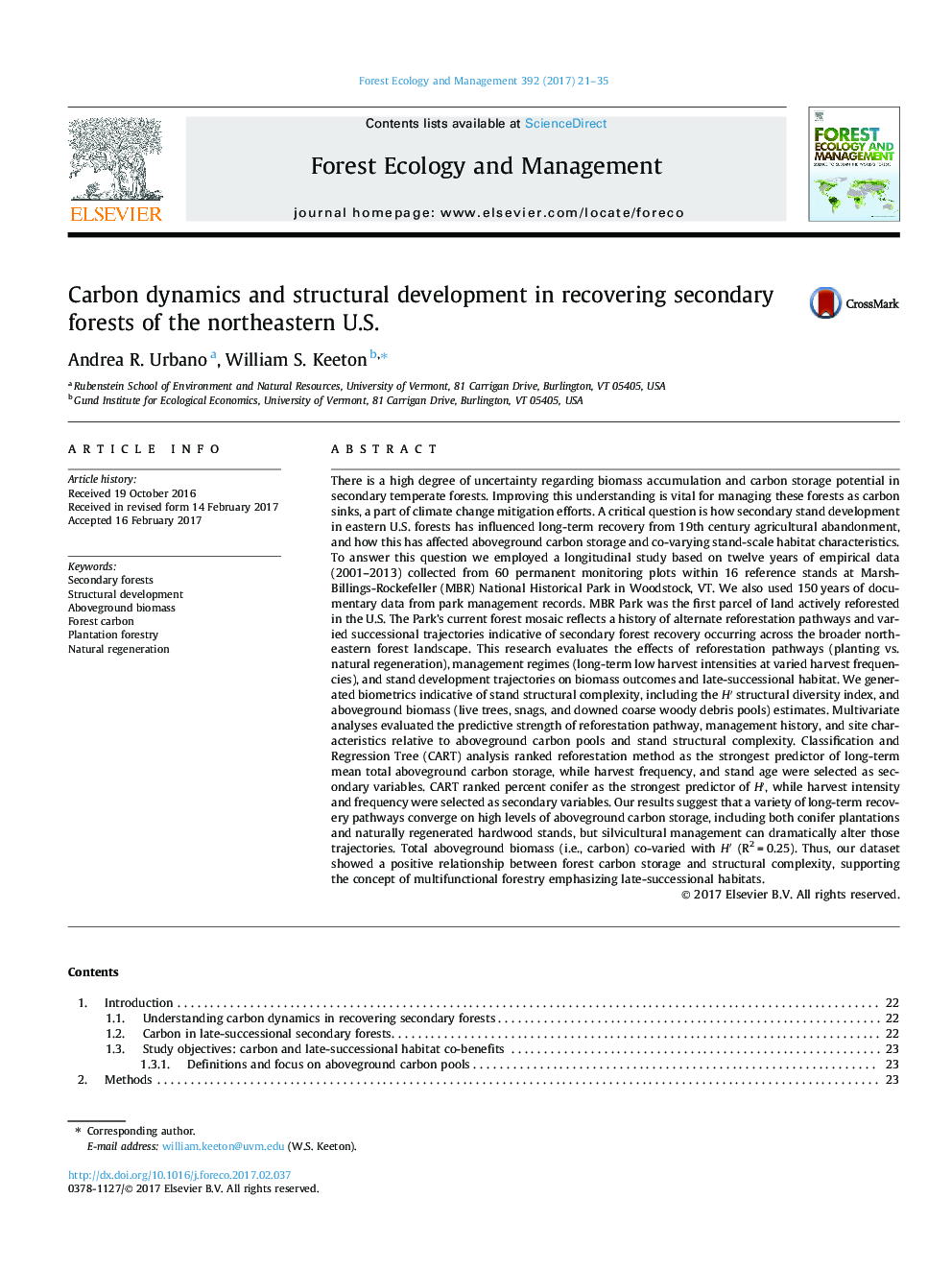| کد مقاله | کد نشریه | سال انتشار | مقاله انگلیسی | نسخه تمام متن |
|---|---|---|---|---|
| 4759461 | 1421366 | 2017 | 15 صفحه PDF | دانلود رایگان |
عنوان انگلیسی مقاله ISI
Carbon dynamics and structural development in recovering secondary forests of the northeastern U.S.
دانلود مقاله + سفارش ترجمه
دانلود مقاله ISI انگلیسی
رایگان برای ایرانیان
کلمات کلیدی
موضوعات مرتبط
علوم زیستی و بیوفناوری
علوم کشاورزی و بیولوژیک
بوم شناسی، تکامل، رفتار و سامانه شناسی
پیش نمایش صفحه اول مقاله

چکیده انگلیسی
There is a high degree of uncertainty regarding biomass accumulation and carbon storage potential in secondary temperate forests. Improving this understanding is vital for managing these forests as carbon sinks, a part of climate change mitigation efforts. A critical question is how secondary stand development in eastern U.S. forests has influenced long-term recovery from 19th century agricultural abandonment, and how this has affected aboveground carbon storage and co-varying stand-scale habitat characteristics. To answer this question we employed a longitudinal study based on twelve years of empirical data (2001-2013) collected from 60 permanent monitoring plots within 16 reference stands at Marsh-Billings-Rockefeller (MBR) National Historical Park in Woodstock, VT. We also used 150Â years of documentary data from park management records. MBR Park was the first parcel of land actively reforested in the U.S. The Park's current forest mosaic reflects a history of alternate reforestation pathways and varied successional trajectories indicative of secondary forest recovery occurring across the broader northeastern forest landscape. This research evaluates the effects of reforestation pathways (planting vs. natural regeneration), management regimes (long-term low harvest intensities at varied harvest frequencies), and stand development trajectories on biomass outcomes and late-successional habitat. We generated biometrics indicative of stand structural complexity, including the Hâ² structural diversity index, and aboveground biomass (live trees, snags, and downed coarse woody debris pools) estimates. Multivariate analyses evaluated the predictive strength of reforestation pathway, management history, and site characteristics relative to aboveground carbon pools and stand structural complexity. Classification and Regression Tree (CART) analysis ranked reforestation method as the strongest predictor of long-term mean total aboveground carbon storage, while harvest frequency, and stand age were selected as secondary variables. CART ranked percent conifer as the strongest predictor of Hâ², while harvest intensity and frequency were selected as secondary variables. Our results suggest that a variety of long-term recovery pathways converge on high levels of aboveground carbon storage, including both conifer plantations and naturally regenerated hardwood stands, but silvicultural management can dramatically alter those trajectories. Total aboveground biomass (i.e., carbon) co-varied with Hâ² (R2Â =Â 0.25). Thus, our dataset showed a positive relationship between forest carbon storage and structural complexity, supporting the concept of multifunctional forestry emphasizing late-successional habitats.
ناشر
Database: Elsevier - ScienceDirect (ساینس دایرکت)
Journal: Forest Ecology and Management - Volume 392, 15 May 2017, Pages 21-35
Journal: Forest Ecology and Management - Volume 392, 15 May 2017, Pages 21-35
نویسندگان
Andrea R. Urbano, William S. Keeton,